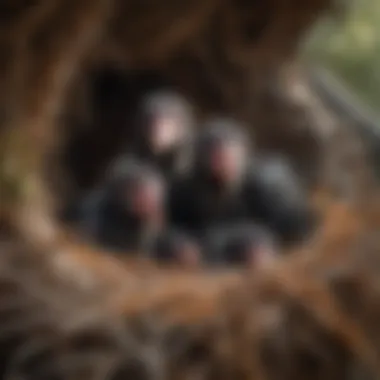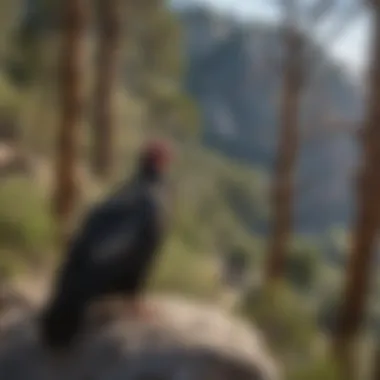California Condor Population: Current Status and Conservation


Intro
The California condor, an iconic symbol of wildlife conservation, faces significant challenges in terms of its population status. Once on the brink of extinction, efforts to revive its numbers have yielded promising outcomes. However, the status of this magnificent bird remains precarious. This article delves into the current population estimates of California condors, evaluating conservation initiatives and exploring their ecological significance, while addressing the challenges these birds encounter.
Understanding the population dynamics of California condors is crucial. It unveils the relationship between their habitat and their numbers, reflecting the intricate balance required for their survival. Conservation programs, such as the California Condor Recovery Program, have played a pivotal role in fostering growth in their population, showcasing the ongoing efforts of various stakeholders.
Furthermore, understanding the ecological importance of the California condor helps underscore the species’ role as a scavenger within their ecosystems. Their survival not only signifies a success story for conservation but also serves as a critical indicator of environmental health.
In the following sections, we will systematically explore the population status, conservation measures, and future prospects for the California condor.
Prolusion to California Condors
California condors are an essential part of the ecosystem in the western United States, notably in California and parts of Arizona. Their presence indicates the health of their habitat, making them valuable to environmental assessments. This section introduces the California condor, a majestic bird that has captured the attention and concern of both scientists and the general public. Understanding this species' current status is pivotal in discussions about biodiversity, conservation, and environmental sustainability.
Defining the California Condor
The California condor (Gymnogyps californianus) stands as one of North America's largest flying birds. With a wingspan that can reach over nine feet, these birds are impressive in size and presence. The adults display a striking plumage, mostly black with white stripes under their wings and a bald head, which aids in thermoregulation during flight.
Condors primarily feed on carrion, playing a critical role as scavengers in their ecosystem. This scavenging habit helps in the breakdown of dead animal matter, thus limiting the spread of disease. Adult condors exhibit social behaviors, often roosting in groups and engaging in complex courtship displays. Their average lifespan can exceed fifty years in the wild, showcasing a long and slow reproductive rate, as they typically lay only one egg every two years.
Historical Range and Population Decline
Historically, California condors thrived along the Pacific Coast, from British Columbia to Baja California. They inhabited diverse environments, including coastal regions, grasslands, and mountainous areas. However, by the 20th century, extensive habitat degradation and human interference led to a dramatic population decline.
Factors such as hunting, lead poisoning from ingesting spent lead bullets, and habitat loss due to urban development contributed to this decline. By 1987, the situation became dire when the entire wild population dropped to just 27 individuals. This alarming figure prompted immediate conservation action, including a controversial captive breeding program enacted by the U.S. Fish and Wildlife Service and other organizations.
The efforts have seen some success, yet the California condor remains critically endangered. Their current status serves as a stark reminder of the impact human activity has on wildlife. Conservationists continue to develop strategies aimed at restoring their population, emphasizing the need for ongoing awareness and protection.
Current Population Metrics
Understanding the current population metrics of California condors is essential for gauging the effectiveness of ongoing conservation actions. These metrics not only reflect the apex of past conservation efforts but also provide a clear insight into the future viability of the species. With an initial steep decline that marked the late 20th century, any fluctuations in the condor population present valuable data for conservational strategies and ecological assessments. These metrics reveal the overall health of the species, which is indicative of broader environmental trends and issues.
Recent Population Estimates
As of 2023, the California condor population stands at approximately 600 individuals, a considerable increase from the low of 27 individuals in 1987. This resurgence can be attributed to the concerted efforts of various organizations and government bodies focused on the survival of this majestic bird. Recent estimates indicate that more than half of these birds now thrive in the wild, with the other half in captivity or undergoing rehabilitation. This balance between wild and captive populations is crucial.
Captive breeding programs conducted by institutions such as the San Diego Zoo and Los Angeles Zoo have played a pivotal role in boosting numbers. Conditions in these facilities allow for controlled breeding, where each pair is carefully selected for genetic diversity. The offspring are then released into the wild, accompanied by rigorous monitoring to ensure their adaptation to natural environments. The meticulous tracking of these released condors has provided direct insight into survival rates and behavioral patterns.
Distribution Across the West Coast
The California condor's distribution is primarily concentrated along the California coast, extending into Arizona and Utah. Significant populations are seen in regions such as Big Sur, Pinnacles National Park, and parts of Southern California. These locations have been designated as critical habitats due to their availability of food sources and suitable nesting sites.
The choice of habitat is crucial. Condors prefer open areas, such as grasslands and mountainous regions, which facilitate their scavenging lifestyle. They often rely on the carcasses of large animals as their primary food source. Therefore, protecting these habitats is tightly interwoven with ensuring the ongoing recovery of populations. Conservation efforts focus on maintaining these vital landscapes while monitoring food availability, essential for the condor's survival.
"Conservation is not just about saving a single species; it’s an effort to preserve a whole ecosystem that's essential for biodiversity and stability."
Regular surveys are conducted to map out the distribution and observe any changes in population densities. These maps are valuable tools for conservationists, allowing them to identify regions where efforts can be intensified or where interventions are needed. As the condors continue to expand their range, understanding their distribution dynamics becomes indispensable for strategic conservation planning.
Factors Influencing Population Numbers


Understanding the factors that influence the population numbers of California condors is crucial for developing effective conservation strategies. These factors provide insight into the challenges faced by this species. Addressing them is essential for ensuring the survival of the California condor, which was once on the brink of extinction.
Lead Poisoning and Environmental Threats
Lead poisoning is one of the most significant threats to California condors. This occurs primarily through the ingestion of spent lead ammunition from carcasses and gut piles left by hunters. When condors consume these contaminated food sources, they suffer severe health problems that can result in death.
Efforts to reduce lead poisoning among condors include advocating for non-lead ammunition, which has been shown to be safer for wildlife. Organizations have promoted legislation to ban lead shots in hunting areas where condors are present. This is one way to mitigate the impacts of lead on populations. However, the full adoption of non-lead materials among hunters remains a challenge.
Additionally, environmental threats such as habitat degradation and climate change can stress condor populations. Higher temperatures and altered precipitation patterns disrupt food sources and nesting sites. These factors complicate the already fragile state of condor recovery efforts.
Key Statistics: Lead poisoning contributes to nearly 50% of known condor deaths each year, highlighting the urgency of addressing this issue.
Habitat Loss and Fragmentation
Habitat loss presents another critical issue affecting California condors. Urban development, agricultural expansion, and other human activities have led to significant reductions in suitable habitat. Condors require wide-ranging areas for foraging and nesting, and as these areas shrink, the birds have less access to food and safe nesting sites.
Fragmentation refers to the breaking up of larger habitats into smaller, isolated patches. This isolation makes it challenging for condors to connect with other populations, which can reduce genetic diversity. Low genetic diversity can affect the birds' resilience to diseases and environmental changes.
Efforts to restore and protect habitats are paramount. This can involve creating protected areas or working with landowners to manage land in a way that supports condor habitats. Increasing awareness about the necessity of habitat conservation among local communities can also help bolster these efforts.
In summary, both lead poisoning and habitat loss play crucial roles in shaping the population dynamics of California condors. Addressing these factors through targeted conservation initiatives is necessary to improve the outlook for this iconic species.
Conservation Efforts in Place
Conservation efforts for the California condor are critical for ensuring the survival of this species. These efforts aim to address the underlying causes of population decline, such as habitat loss, lead poisoning, and other environmental threats. Conservation initiatives serve as a multifaceted approach to not only protect the existing condor population but also to foster conditions that allow for natural growth.
Captive Breeding Programs
Captive breeding programs are a cornerstone of the conservation strategy for the California condor. The main purpose of these programs is to increase the genetic diversity and number of condors in a controlled environment. Strategies are developed to breed individuals with careful genetic pairing, which boosts the likelihood of successful offspring.
Originally, the population of wild California condors was down to just 27 individuals in 1987. Today, through intensive captive breeding efforts, that number has risen to over 500 individuals. These programs involve not just breeding but also rigorous health assessments and behavioral training to prepare young condors for eventual release into the wild.
Key aspects of captive breeding include:
- Genetic Management: Careful selection of breeding pairs to avoid inbreeding.
- Husbandry Practices: Providing optimal conditions for nesting and chick rearing.
- Monitoring: Keeping track of the health and behavior of both captive and released condors.
These initiatives have proven effective, significantly increasing the number of California condors, though they come with a set of challenges that require ongoing attention.
Rehabilitation and Release Strategies
Post-breeding, the rehabilitation and release strategies are paramount for transitioning California condors back into their natural habitats. This phase involves preparing the young condors for the challenges they will encounter in the wild, which include locating food, avoiding human developments, and adhering to social structures with other wild condors.
The rehabilitation process includes:
- Pre-release Training: Young condors undergo a process that mimics wild survival skills through exposure to natural environments.
- Monitoring from Release Points: Released condors are often equipped with tracking devices that provide data on their movements and behaviors in real-time.
- Continued Support: Conservation organizations provide ongoing support and intervention for newly released condors to ensure their adaptation is successful.
These rehabilitation efforts showcase the commitment to not only reviving the condor population but ensuring that these birds can thrive long-term in their ecosystems. However, the success of such strategies hinges on continued funding and public awareness.
"Conservation is not only about preserving wildlife but also about understanding ecological interactions that sustain these species."


In summary, conservation efforts place a substantial emphasis on captive breeding and rehabilitation. By focusing on these areas, organizations aim to create a stable environment for California condors to repopulate and coexist with their surrounding ecosystems.
Habitat Preservation Initiatives
Habitat preservation is crucial for the survival of the California condor, which struggles against habitat loss due to urban development, agriculture, and other human activities. Protecting their natural environments directly influences their breeding success, feeding behavior, and overall health. The loss of suitable habitats can lead to decreased food availability and increased mortality rates among young condors.
Protecting Key Eco-regions
The California condor inhabits various eco-regions, including coastal cliffs, scrublands, and mountain ranges. Each of these habitats serves as a unique ecological niche that supports the condor's lifecycle. Effective habitat preservation initiatives encompass strategies like:
- Establishing protected areas: National parks, wildlife reserves, and protected land corridors can ensure that critical habitats remain undisturbed.
- Restoration of degraded habitats: Efforts should focus on restoring natural vegetation and landscapes that have been damaged.
- Ecological monitoring: Ongoing assessments of habitat quality help identify areas needing intervention.
Such protection enables condors to thrive by ensuring their access to roosting sites, foraging areas, and breeding habitat.
Community Involvement in Conservation
Community engagement plays a vital role in habitat preservation initiatives. Local residents and stakeholders can contribute in different ways:
- Volunteering for clean-up efforts: Communities can organize events to remove trash and debris from condor habitats, thus improving ecological conditions.
- Participating in educational programs: Knowledge is power. Engaging locals fosters a better understanding of conservation issues related to California condors, which can lead to increased support for protective measures.
- Advocating for local policies: Informed communities can influence decision-making, promoting zoning laws that protect condor habitats from development.
Supporting habitat preservation through community involvement not only aids the California condor’s recovery but also strengthens connections across societies, reinforcing a collective responsibility for wildlife conservation.
"Successful condor conservation hinges not just on sound science, but also on the active participation of communities across California."
Ecological Importance of California Condors
The California condor plays a crucial role in its ecosystem. As scavengers, these birds contribute significantly to nutrient recycling in their habitats. Their feeding habits help control diseases by consuming carrion, which can otherwise harbor pathogens. This process is essential for maintaining the health of the ecosystem.
Condors also indicate the state of the environmental health. The presence of these birds in an area suggests a balanced ecosystem with adequate food sources. The decline of the condor population can signal deeper ecological issues that require attention. Therefore, their survival is not just about preserving a single species but also about safeguarding biodiversity and ecological integrity.
Role in Ecosystem Dynamics
The role of California condors in ecosystem dynamics is multifaceted. They typically inhabit open grasslands and forested areas where they can find carrion. By feeding on dead animals, condors fulfill an important ecological role. They help to eliminate decomposing matter, which can otherwise attract pests.
Furthermore, condors have a unique digestive system, allowing them to consume potentially harmful carcasses without falling ill. This adaptation helps reduce the risk of disease transmission in the environment. Their foraging behavior also influences the composition of local wildlife, as they can affect the populations of other scavenger species by competing for food resources.
Implications for Biodiversity
The implications of California condors for biodiversity are profound. Their potential extinction could lead to significant disruptions in the ecosystems where they live. For instance, if condors disappear, other scavengers might proliferate, possibly leading to over-consumption of carrion and affecting other animal populations.
In addition, condors are significant per their role in the food web. They not only feed on large dead animals, but influence the ecological balance of their habitats. Their decline might encourage a shift in the dynamics among various species, thus altering community structures.
Public Awareness and Education
Public awareness and education are crucial components in the conservation of California condors. Understanding the current population status and the threats these birds face can galvanize community support and engagement. As an iconic species, California condors serve as a powerful symbol for conservation efforts, highlighting the biodiversity challenges that exist in modern ecosystems. Efforts to educate the public can lead to better informed individuals that actively participate in conservation initiatives.
Promoting awareness entails clear communication about the population challenges the California condor faces, including lead poisoning, habitat loss, and environmental threats. When individuals comprehend these issues, they are more likely to change behaviors that support the species survival. This includes advocating for habitat conservation and supporting policies that address environmental hazards.
Outreach Programs and Community Engagement


Outreach programs are instrumental in building community engagement. Organizations dedicated to the conservation of California condors, such as the U.S. Fish and Wildlife Service, frequently organize events to inform the public. These programs often involve interactive activities that resonate with both children and adults.
Through these programs, participants learn about the life cycle of the California condor, their environmental role, and the ongoing efforts to protect them. Engaging community members in hands-on activities, like local birdwatching events or habitat restoration days, increases investment in the survival of this species. Furthermore, these outreach initiatives can lead to local partnerships that offer long-term support and resources for conservation efforts.
Educational Initiatives for Schools
Educational initiatives targeting schools are vital for shaping the next generation's understanding of biodiversity and conservation. Programs that integrate the California condor into science curricula help students comprehend broader environmental issues.
By developing lesson plans that include field trips to see wildlife in their natural habitats, students can witness conservation efforts firsthand. Interactive projects, such as creating informative displays or conducting research on condor population metrics, foster a sense of responsibility towards the environment. Schools can also collaborate with conservation organizations to enhance educational content, making it relevant and impactful.
Involving students in conservation creates stewards of the environment. When young people engage in discussions about the importance of protecting species like the California condor, they are likely to carry these lessons into adulthood, promoting a culture of conservation for years to come.
"Education is the most powerful weapon which you can use to change the world." - Nelson Mandela
Future Outlook
The future outlook for California condors is crucial in framing conservation discussions and establishing long-term strategies for their survival. A careful understanding of the population trends, environmental conditions, and conservation policies each play a vital role in determining how this iconic species adapts and thrives in the coming years. Addressing the key elements of the future status of these birds involves recognizing ongoing threats, potential recovery strategies, and the collaborative efforts required for success.
Challenges Ahead
California condors face multiple challenges that hinder their recovery. One of the major obstacles is lead poisoning, often due to ingestion of spent lead ammunition. This issue reduces their lifespan and reproductive success, maintaining a cycle of population decline. While steps have been taken to reduce lead exposure, full enforcement and community compliance remain difficult.
Additionally, habitat loss continues to threaten condor populations. Urban development, wildfires, and agricultural expansion can degrade and fragment the habitats critical for their lifestyle. Without these habitats, the birds struggle to find food and nesting sites.
Moreover, climate change introduces new uncertainties. Changes in temperature and precipitation patterns impact food availability and breeding cycles. As ecosystems shift, the adaptability of condors will be tested. Ensuring resilient populations will necessitate innovative conservation approaches, which can be both complex and costly.
Opportunities for Continued Recovery
Despite these challenges, there are several promising opportunities for the recovery of California condors. To begin with, enhancing captive breeding programs can play a pivotal role. Organizations like the Los Angeles Zoo and San Diego Zoo have made significant progress in breeding efforts. By increasing the number of individuals in the wild, the genetic diversity can be improved, making populations more resilient.
Furthermore, expanding habitat protection efforts presents an excellent avenue for future success. Establishing protected areas and green corridors will help mitigate the effects of habitat fragmentation. Collaborative efforts with landowners and conservation organizations are vital for creating these safe spaces for condors.
Public engagement is another critical component in ensuring ongoing recovery. Increased awareness campaigns can educate the public on conservation efforts and the importance of lead-free ammunition. Effective outreach can foster a sense of community responsibility, encouraging individuals to partake in local conservation initiatives.
"The recovery of California condors is a testimony to what can be achieved through dedicated conservation efforts, and the future can be shaped positively through collective action."
Ending
The conclusion of this article serves to encapsulate the myriad factors influencing the current status of California condors, a species emblematic of conservation challenges. In discussing the conservation status, it is crucial to underscore how interventions and initiatives are not mere conservation efforts but rather moral imperatives that resonate deeply within ecological frameworks.
Summarizing Condor Conservation
Over the past few decades, efforts dedicated to California condor conservation have made significant strides. Programs such as those implemented by the U.S. Fish and Wildlife Service have emphasized captive breeding and stringent monitoring of rewild populations. The condor population has seen a gradual increase, from a rocky low of 27 individuals in the 1980s to a population that, as of recent estimates, totals over 500 birds, both in captivity and free-flying.
The focus on lead poisoning as a primary threat led to far-reaching legislative measures aimed at reducing lead ammunition usage in California and beyond. Protection of key habitats is another vital aspect. Specific areas in California and the Southwest have been designated as condor sanctuaries, ensuring that these birds have the necessary resources to thrive. Although the data shows encouraging signs, the full recovery of this species remains an intricate process, dependent on sustained efforts and vigilance.
Call to Action for Conservation Efforts
Despite positive trends, California condors still stand on the precarious edge of extinction. Ongoing threats from habitat degradation, microtrash ingestion, and climate change necessitate continued commitment to conservation work. Therefore, there is an urgent need for robust public support and engagement in conservation endeavors.
Key stakeholders such as policymakers, local communities, and nonprofit organizations must work collaboratively to strengthen conservation frameworks. Public education initiatives can play a transformative role, fostering an understanding of the condor’s ecological significance and making the case for ongoing protection efforts. Educators and wildlife advocates should leverage conversations around California condors as a platform to highlight broader issues of biodiversity loss and habitat conservation.
"The persistence of California condors in the wild is a testament to human resolve in wildlife conservation. Each bird is a symbol of hope, and collective actions can ensure their survival for future generations."
In essence, a multi-faceted approach that combines legislation, public awareness, and habitat preservation measures will be crucial for the future of California condors. The time for decisive action is now, as every effort counts in securing not just the future of this magnificent species, but also the health of our shared ecosystems.







